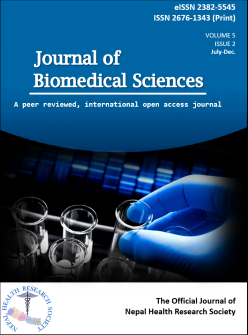Quorum sensing: A molecular cell communication in bacterial cells
DOI:
https://doi.org/10.3126/jbs.v5i2.23635Keywords:
Autoinducers, Bacterium, Gram positive, Quorum sensing, Staphylococcus aureus, Vbrio fischeri, Vibrio harveyiAbstract
Background: Quorum sensing is a cell-to-cell communication, which is extensively observed in bacteria. This process allows the cell to detect, analyze, share and act upon various environmental stimuli based on cell density. The molecular aspect of this process is the secretion and detection of chemical signaling molecules called autoinducers (AIs), which act upon the gene expression. The quorum sensing signaling pathway is specifically observed only bulk population or in other words, the quorum sensing is effective only in high cell density. The quorum sensing circuit in the bacterial population is widely studied under the following heading; quorum sensing in Gram positive bacterium, Quorum sensing in Gram negative bacterium and the Quorum sensing with respect to Interkingdom communication. These models are studied using the widely studied models like Vibrio fischeri in Gram negative QS circuit, Staphylococcus aureus in Gram positive QS circuit and Vibrio harveyi. This review paper details the introduction of quorum sensing and their gene level explanation and how they effect on the virulence of a particular species of bacteria. This paper also throws light on the realization that the bacteria has the capable of performing coordinated activities that was so long contributed to the eukaryotic cell performance.
Downloads
Downloads
Published
How to Cite
Issue
Section
License
This license enables reusers to distribute, remix, adapt, and build upon the material in any medium or format, so long as attribution is given to the creator. The license allows for commercial use.




